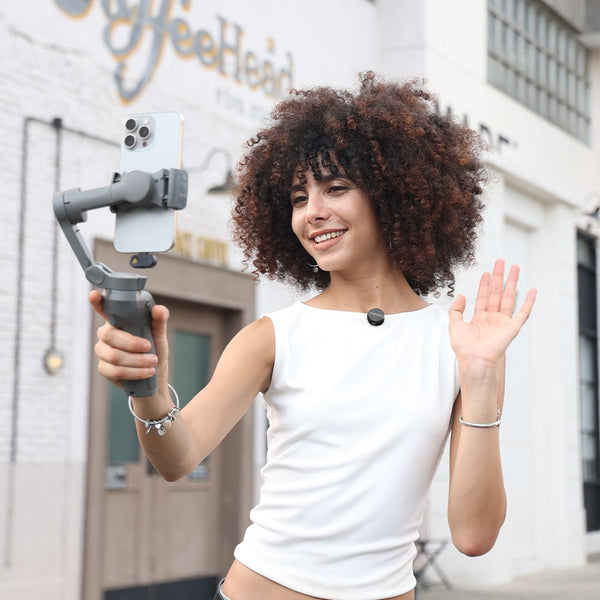Have you been noticing musicians performing on the street on Facebook lately and asking strangers to collaborate with them? Have you wondered what type of microphones they're using? Let's find out.
For people out on the streets doing their own thing, it takes high-quality audio and great music to grab their attention. Cardioid pattern microphones are a popular choice if singing and making music on the streets is your passion.

Recording Street Vocal Jams: What You Need to Know About Cardioid Pickup Patterns
Street performances and vocal collaborations bring an energy that can’t be replicated in a studio. But capturing that raw, dynamic sound with clarity—especially when two vocalists are jamming live on a bustling street—requires the right microphone strategy. Enter the cardioid microphone.
Cardioid microphones are designed to capture sound primarily from the front while rejecting noise from the sides and rear. This unique cardioid microphone pickup pattern makes them ideal for street settings, where background chatter, passing traffic, or wind can interfere with vocal clarity. But to truly master the sound of a street duo, you need more than just a mic—you need proper positioning, the right gear, and solid techniques.
In this guide, we’ll walk you through how to get the best sound out of your street vocal collabs using cardioid condenser microphone or cardioid dynamic microphone options, and other essential gear—with a focus on real-world setups, troubleshooting, and top mic recommendations like the Maono HD300T and Maono PM500.
Top Gear Setup for Street Singing Duos: Mic Positioning & Mixing Tips
When two vocalists perform together on the street, capturing both voices clearly with a single cardioid mic—or even two—requires smart positioning and the right accessories.
1. Mic Positioning:
The cardioid microphone pattern has a “sweet spot” directly in front of its capsule. For duos, try placing a single cardioid pattern microphone slightly in front and between both singers, angled slightly toward each person. For best results:
-
Keep the singers within 6–12 inches of the mic.
-
Avoid having them stand directly side-by-side (which places them in the mic’s rejection zone).
-
Consider a slight "V" angle between singers, with the mic facing the center.
2. Use of Two Cardioid Mics:
For more separation and clarity, give each singer their own mic. Position them so that the rear of each cardioid condenser microphone faces the other singer, minimizing bleed and phase issues.
3. Mixer or Audio Interface:
If you’re using multiple mics, a compact mixer or portable audio interface can help you blend the sound in real time. For street performances, battery-powered options or portable recorders with multiple XLR inputs work well.
4. Windscreens and Pop Filters:
Always use foam windscreens for outdoor work—these help reduce wind noise without over-dampening your vocals. A pop filter can be mounted on a stand if you're staying stationary.
Street Collaboration: Using Cardioid Mics to Isolate Vocals in Noisy Environments
Isolation is where cardioid microphones really shine. Their directional nature allows you to highlight the vocal sound while minimizing ambient street noise.
1. Facing the Right Direction:
Ensure the mic is pointed away from the noisiest part of the environment (like a busy street or crowd). This puts the cardioid microphone pickup pattern to work.
2. Close-Miking Technique:
The closer the mic is to the source (the singer), the better the signal-to-noise ratio. Close-miking also benefits from the proximity effect, adding warmth and presence to vocals—especially true with cardioid dynamic microphones.
3. Portable Acoustic Shields (Optional):
For stationary performances, a small portable mic shield can help block rear and side reflections—great for boosting clarity in acoustically chaotic locations.
Troubleshooting Sound Quality During Street Vocal Collaborations
Despite best practices, street setups often require on-the-fly troubleshooting. Here are a few common issues and how to fix them:
1. Unbalanced Volume Between Singers:
-
Ensure both vocalists maintain a consistent distance from the mic.
-
Adjust gain levels independently if using two mics.
-
Use compression during mixing or live with caution to balance peaks.
2. Excessive Background Noise:
-
Recheck mic direction.
-
Use foam windscreens and place singers with their backs toward noise sources.
-
Consider noise gate settings if recording into a DAW or smart recorder.
3. Wind or Plosive Issues:
-
Use proper wind protection.
-
Adjust the mic angle slightly downward or off-axis from the mouth.
4. Mic Feedback or Distortion:
-
Use headphones for live monitoring.
-
Keep mic gain lower and adjust the mix during playback.
-
Use a limiter to catch unexpected peaks.
Frequently Asked Questions (FAQs):
1. What’s the best mic placement for a duo using a cardioid mic outdoors?
Place the mic centered between the two vocalists, angled slightly toward each. Ensure they stand close (within 12 inches) and not directly side-by-side.
2. Does singing side-by-side work with a cardioid mic, or should vocalists take turns?
Taking turns gives cleaner results, but if singing together, use a staggered position or angle the mic to catch both voices evenly.
3. How do you reduce background noise in a noisy street when using a cardioid mic?
Face the mic away from the noise source, use a windscreen, and apply close-miking. Use dynamic processing like gates or noise reduction plugins during post.
4. What’s the best mic stand or boom arm setup for outdoor street vocals?
Use a tripod-based boom stand for versatility and stability. Look for lightweight, foldable options with sandbag weights for windy conditions.
5. Should you use a windscreen or pop filter for street singing with a cardioid mic?
Use a windscreen always; pop filters help with plosives but may be impractical outdoors unless the mic is stationary.
6. Can battery-powered audio interfaces or portable recorders work well for these setups?
Yes! Devices like the Zoom H6 or Tascam DR-40X are excellent for on-the-go recording. Pair with rechargeable audio interfaces if you're using XLR mics.
7. What are the pros and cons of using a cardioid mic for two street vocalists vs. an omnidirectional one?
Cardioid Pros: Better noise rejection, focused capture.
Cons: Narrow pickup area—requires smart placement.
Omnidirectional Pros: Easier for groups.
Cons: Picks up more background noise—less ideal for street setups.
8. What apps or portable recorders are best for syncing street collab audio with video?
-
Apps: Dolby On, BandLab, or Rode Reporter for mobile.
-
Recorders: Zoom H1n, Tascam DR-10L, or using a wireless lavalier mic system with phone sync.
9. Can cardioid mics be used to livestream street music performances?
Absolutely. Just ensure you have an audio interface or mixer with USB or smartphone support, and check your mic’s compatibility with the streaming app.
10. What’s the best cardioid mic for street vocals with limited gear?

-
Hybrid USB/XLR design
-
Dynamic cardioid microphone — great for noisy environments
-
Low self-noise and rugged build
-
Studio-grade cardioid condenser microphone
-
Ideal for richer detail when you're not competing with too much ambient noise
-
Great with a portable Maono AME2) audio interface or recorder
Both offer excellent value and performance, with flexible connectivity for street vloggers and music duos.
Conclusion
Whether you're busking on the street, filming a duet vlog, or recording spontaneous jams with friends, capturing clear and impactful vocals depends heavily on your mic setup. Cardioid microphones are your best allies for isolating vocals in noisy outdoor environments, but technique, gear choice, and positioning matter just as much.
Using the right cardioid microphone pattern, wind protection, and real-time troubleshooting tips can bring professional-quality sound to your rawest and most authentic moments. Also, with reliable mics like the Maono HD300T and PM500, you don’t need a studio to sound like a star.
So get out there, collaborate, and let your voice be heard—loud, clear, and street-smart get your cardioid microphone now from Maono!
Also Read:



